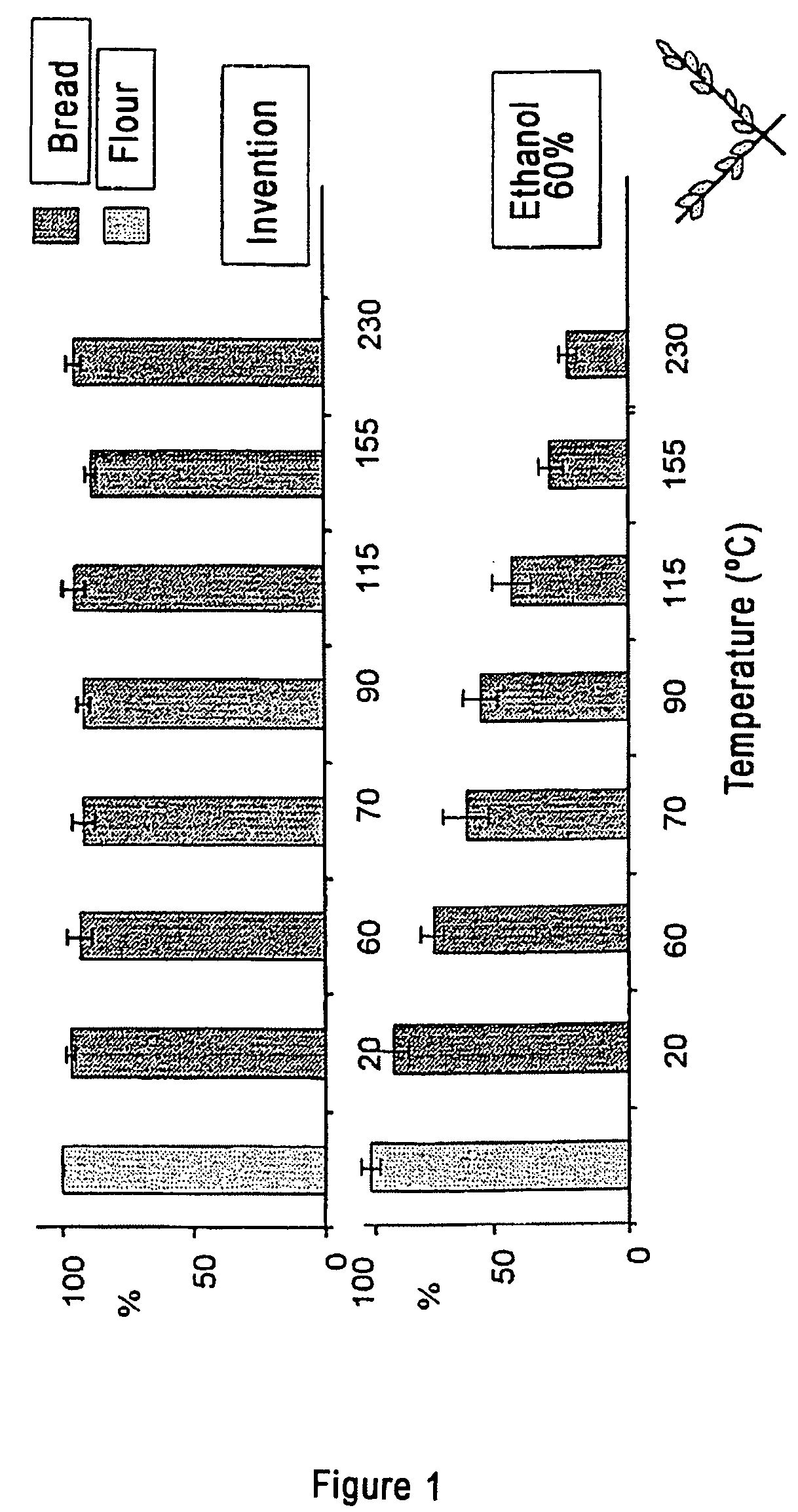Process to extract gluten from food products and kit for achieving same
a technology of food products and kits, applied in the field of process to extract gluten from food products and kits for achieving same, can solve the problems of inability to reliably measure lack of reliable method of measuring the gluten content of food items, and inability to use the elisa tes
- Summary
- Abstract
- Description
- Claims
- Application Information
AI Technical Summary
Benefits of technology
Problems solved by technology
Method used
Image
Examples
example 1
[0033]Recovery of Gluten from Heat-Treated Food Products
[0034]This experiment was carried out to compare the efficacy of the procedure provided by this invention to extract gluten from heat-treated food items, at different temperatures, compared to the method usually used (Reference method).
[0035]1.1 Materials
[0036]The following food items were used for this example:
[0037]A) Food items treated at high temperatures during the manufacturing process (180-220° C.):
[0038]A.1) “Gluten-free” but contaminated with gluten (i.e. food products that claim not to contain gluten but that do in fact contain gluten); and,
[0039]A.2) Food items that contain gluten; and
[0040]A.3) “Gluten-free” food items not contaminated with gluten (i.e. foods that do not contain gluten for use as controls).
[0041]B) Foods treated at intermediate temperatures (approximately 110° C.); starches contaminated with gluten.
[0042]1.2 Reference Method
[0043]The reference method is the method currently used to extract gluten th...
example 2
[0057]Quantitative Recovery of Gluten in Heat-Treated Food Products
[0058]This experiment illustrates the quantitative recovery of gluten, obtained by the process of the invention foods treated at different temperatures compared to the non-quantitative recovery of gluten obtained using the usual extraction method with 60% ethanol (Reference method).
[0059]2.1 Materials
[0060]To carry out this experiment the following were used:
[0061]1) breads made at different temperatures: 20° C., 60° C., 70° C., 90° C., 115° C., 150° C. and 220° C.; and
[0062]2) the flour used to make these breads
[0063]2.2 Reference Method
[0064]The reference method used is that currently used to extract gluten using a 60% aqueous ethanol solution (see Example 1.2).
[0065]2.3 Process of the Invention
[0066]The process of the invention consists in extracting gluten using and aqueous ethanol solution of 60% in the presence of a reducing agent and a dissociating agent and in the presence of a buffer of pH 7-8 (see Example 1...
example 3
[0069]Gluten Recovery in Non Heat-Treated Foods
[0070]This experiment was carried out to compare the efficacy of the process of the invention to extract gluten from foods not treated with heat with that of the method usually used (Reference method).
[0071]3.1 Materials
[0072]To perform this experiment, 7 samples of wheat flour (Wh) were used and 1 of rye (R) that had not been submitted to any heat treatment (see Table 2).
[0073]3.2 Reference Method
[0074]The reference method is the method currently used to extract gluten using an aqueous ethanol solution of 60% (see Example 1.2).
[0075]3.3 Process of the Invention
[0076]The process of the invention consists in extracting gluten using an aqueous ethanol solution of 60% in the presence of a reducing agent and a dissociating agent and in the presence of a phosphate buffer of pH 7-8 [see Example 1.3].
[0077]3.4 Results
[0078]Table 2 shows the ELISA values of 8 food samples not treated with heat. This Table 2 clearly shows an increased percentage...
PUM
| Property | Measurement | Unit |
|---|---|---|
| Temperature | aaaaa | aaaaa |
| Temperature | aaaaa | aaaaa |
| Fraction | aaaaa | aaaaa |
Abstract
Description
Claims
Application Information
 Login to View More
Login to View More - R&D
- Intellectual Property
- Life Sciences
- Materials
- Tech Scout
- Unparalleled Data Quality
- Higher Quality Content
- 60% Fewer Hallucinations
Browse by: Latest US Patents, China's latest patents, Technical Efficacy Thesaurus, Application Domain, Technology Topic, Popular Technical Reports.
© 2025 PatSnap. All rights reserved.Legal|Privacy policy|Modern Slavery Act Transparency Statement|Sitemap|About US| Contact US: help@patsnap.com


